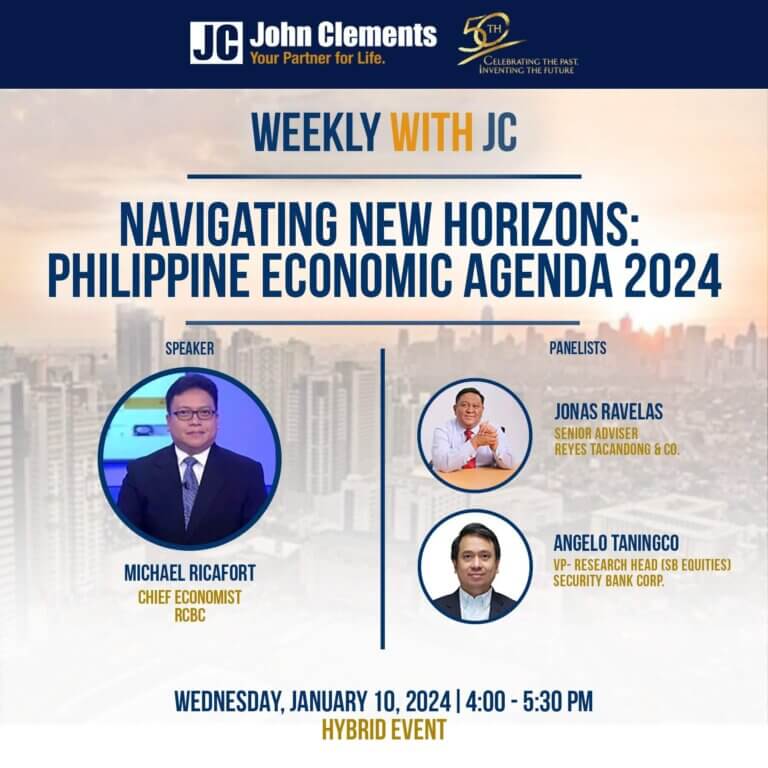As the Philippines enters 2024, there’s a mix of anticipation and scrutiny in its economic landscape. Businesses want to learn what growth opportunities to explore and individuals want insights into financial security. Let’s take a closer look at the outlook of the Philippine economy and the insights shared by industry experts at the recent Weekly with JC event, “Navigating New Horizons: Philippine Economic Agenda 2024.”
On January 10, 2024, three esteemed speakers—Michael Ricafort, Chief Economist of Rizal Commercial Bank Corporation (RCBC); Jonas Ravelas, Senior Adviser at Reyes Tacandong & Co; and Angelo Taningco, Vice President Research Head at Security Bank Corp—shed light on the Philippine Economic Outlook for 2024.
A Snapshot: The Philippine Economy Today
Michael Ricafort, recognized as the Best Income Strategist and Best Economist in 2022, forecasts positive growth for the Philippines. He ranked the country at #37 in terms of GDP growth, with the potential to climb higher. His predictions included an impressive 67% economic growth based on Philippine demographics.

Top 3 Allocation of Funds in the Philippines
- Education: The Philippines is prioritizing education in 2024. Significant funds are earmarked to revolutionize the educational landscape, focusing on digital literacy. This includes providing devices, internet connectivity, and developing e-learning platforms, ensuring the youth are equipped for the digital age.
- Infrastructure: Infrastructure development takes center stage, with major projects under the “Build, Build, Build” program. Highways, bridges, airports, and seaports aim not only to improve connectivity but also to stimulate economic activities, create jobs, and foster regional development.
- Healthcare: A robust healthcare infrastructure is a key focus. The funds allocated aim to strengthen healthcare systems, including constructing and upgrading hospitals and health facilities, ensuring quality medical care is accessible to all Filipinos.
Insights from Experts
Jonas Ravelas emphasized the need for prioritizing business spending on infrastructure to make tourism and manufacturing impactful. He also raised concerns about the dependence on Chinese nationals as a major driver in Philippine tourism.
Angelo Taningco predicts positive GDP growth in 2024, with lower inflation and interest rates. However, he underscored the importance of attracting more foreign investors to boost the relatively small Philippine economy.

3 major challenges confront the Philippines in achieving sustainable growth:
- Inflation: Managing inflationary pressures from global factors and domestic influences is crucial in 2024.
- Employment: Balancing economic expansion with job creation is a pressing concern, requiring investments in skills development and education.
- Corruption: Tackling corruption is vital for sustainable growth, as it erodes public trust and hampers both foreign and domestic investments.
Bright Spots in the Economic Situation in the Philippines
- Philippine GDP Growth Estimate: The Philippine GDP growth is expected to return to a more normal range, with estimates ranging between 5.5% and 6.5% in 2023 and over the next 5-10 years. This indicates positive economic performance and suggests potential stability and growth in the country’s overall economic output.
- Lower Individual Income Tax Rates: Beginning in January 2023, the Philippines implemented lower individual income tax rates as part of the Tax Reform for Acceleration and Inclusion (TRAIN) Law. This means that individuals in various income brackets will experience reduced tax burdens, potentially leaving them with more disposable income.
- Measures to Reopen the Economy: Efforts to reopen the economy have resulted in positive outcomes such as increased sales, revenues, incomes, livelihoods, and employment. This implies that the strategies employed to return to normal economic activities have been successful and are contributing to overall economic recovery.
- Low Unemployment Rate: The unemployment rate in the Philippines stands at 3.6%, marking the lowest level in at least 18 years. This is in alignment with other countries in the Association of Southeast Asian Nations (ASEAN), indicating a positive trend in employment and labor market conditions.
- Inflation Eased to 3.9%: Inflation in the Philippines decreased to 3.9% in December 2023, approaching the slowest rate in the past two years. This is within the target range set by the Bangko Sentral ng Pilipinas (BSP), which aims to maintain inflation between 2% and 4%. Controlling inflation is crucial for economic stability and purchasing power.
In summary, these statements collectively suggest positive indicators for the Philippine economy, including expected GDP growth, lower individual income tax rates, successful measures to reopen the economy, a low unemployment rate, and controlled inflation.

Keep up to date with our webinars, workshops, and training sessions, and visit our Events page today for details.




